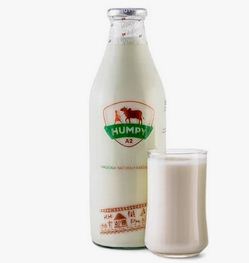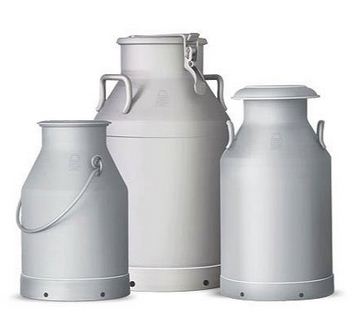Introduction:
Milk has been packaged in several types of containers across the globe. The general requirements of a Milk Packaging container are as follows:
- It must be tamper proof, so that it is protected against fraudulent practices between the time of milk packaging and consumption.
- It must be of such a size that the capacity always relates to the keeping quality of the product and that its contents correspond to the consumer’s daily requirements.
- It must be clean and attractive.
A container of good quality must prevent post-processing contamination from bacterial sources. It should be such that all indirect or direct chemical change in the milk should be prevented.
The package should be of such materials that their constituents do not get transmitted into milk. It should also be resistant to the cleaning materials used in the dairy.It may either be used once (single-use) or may be returned to the processing factory for reuse.
Types Of Milk Packaging Materials
Single-use Packaging Materials for Milk Packaging
These are also classified as flexible packaging. They, as the name suggests, are used to Milk Packaging once and are discarded after removing the product. The consumer is responsible for disposing off the packages. They have been in the news in recent times due to the difficulty in their disposal and their role in environmental pollution.
Plastic pouches:
Flexible plastic material can be made into pouch packs. As they are not self-supporting, they generally need some secondary packaging.

The advantages offered by the plastic packages For Milk Packaging:
- good barrier properties
- visibility of the contents
- light weight (thus reducing the cost of transportation)
- single-service, thus eliminating the need for return, washing and sanitation
- easy to carry
- economical and
- can be made more attractive.
The most commonly used plastic material for pouches in milk packaging are polyethylene (PE). There are several types of polyethylene available and are characterized by their density. These are low density (LDPE – 0.91-0.925 g/cm3), medium density (MDPE –0.926-0.941 g/cm3) and high density (HDPE – 0.942-0.970 g/cm3).
The material has good moisture barrier properties, but poor oxygen barrier characters. HDPE is the least permeable to moisture. PE is suitable both for rigid and flexible packaging,though for some applications, it must be combined with an oxygen barrier.
Flexible pouches are also made from a derivative of polyvinyl chloride (PVC) in the plasticised form (PPVC). It contains plasticisers to render it flexible and stabilizers to prevent thermal and UV light degradation of the product. However, there has been some controversy regarding its toxicity owing to the high chloride content and additives present.
The use of plastic pouches eliminates noise in the milk bottling plants and during delivery, and also reduces water pollution caused by milk residues and detergents used in the bottle washing process. However, they have the disadvantage of poor recyclability and hence, their disposal is a problem.
Carton:
The history of the beverage carton is closely associated to the development of milk distribution. The first carton was patented in 1915 in the USA as a ‘folded blank box’.
Cartons generally have a square or rectangular cross-section. Tetrahydral and other shapes are also seen, though rarely. These are manufactured by well-developed systems. They are high-technology packaging formats and need well-trained operators to ensure efficient filling of the product and used for milk packaging.
The serving size is also important while designing the package. A 200- or 250 ml single serve packet may be marketed with a straw and if a multiserve (say, one litre), some sort of reclosable feature should be provided.
These kinds of packaging materials are normally used for long-life products that need not be refrigerated during storage.
The form-and-fill types of cartons are normally used for milk packaging. They are normally received as rolls of heat-sealable milk packaging material.
The material is laminated paper, consisting of duplex kraft paper coated with PE inside and wax outside. A sandwiched layer of thin aluminium foil between an outer kraft paper and inner PE coating is also prevalent.
The advantages of carton packaging for milk packaging
- Lightweight and compact shape, thus increasing distribution efficiency
- Made from renewable raw material (wooden fibre)
- Hygienic
- One way containers, so no need for cleaning before or after filling operation,hence decreasing water and detergent usage
- Recyclable
- Easy to dispose
The distinct disadvantage also is the felling of trees for making the raw material.However, it is a renewable source and can be regenerated with the help of strict laws and effective management.

Paper and paper-based Materials for milk packaging:
Several kinds of paper-based materials are used in the form of wrappers, cartons, boxes, bags and cups, while boards are used as cartons and boxes .
These materials are made of bleached or unbleached kraft paper, grease-proof paper, vegetable parchment paper, glassine paper, wax-coated paper, plastic-coated paper, straight or corrugated paper boards, solid fibre boards,liner boards and box boards.
While boxes and cartons are used generally for packaging products other than fluid milk, they may sometimes be useful in constructing the outer casing material (secondary packaging) for long distance transportation of flexible pouches.
Multiple-use Packaging Materials for milk packaging
Of the possible pack types, bottles are the most commonly used multiuse packages.They can be made of glass and plastic. Metal bottles have also recently emerged for specialist markets, but they are rare and expensive.
Glass:
Glass containers come in the form of bottles, jars, jugs and tumblers. They may be plain and transparent or coloured and opaque.
While the plain glass bottle provides the advantage of direct viewing of the product contained in it, it has the disadvantage of exposing the milk to ultra violet rays that deteriorate it.
Glass has many virtues, but also has several disadvantages that limit its use as a milk packaging material.

Advantages of glass:
- Strong, inert material
- Good closure and decorative options
- Raw materials easily available
- Recycling possible
- Excellent gas and water barrier properties
- Quality image
- Product compatibility
- Good internal pressure resistance
- Reuse opportunity
Disadvantages of glass:
- Heavy
- Brittle
Despite its disadvantages, the older generation of consumers still thinks of glass as the best option for packaging milk.
Plastic:
Plastic bottles for milk packaging generally are made with ribs to add strength. This additional tenacity is needed for withstanding the vacuum on filling machines, for resisting the lateral forces that act within the pack and during transit.
Plastic bottles may be manufactured from PVC, HDPE or polyethylene terephthalate(PET). Of these, the first two are generally considered together because of the type of moulding machines they are made on and the type of bottle that can be made.
PET occurs in three physical forms (amorphous, orientated and crystalline), which are exploited to manufacture a wide range of packaging materials.
PET bottles are made in two steps.
The first is to make a ‘perform’, which is in the shape of a test tube with the actual neck of the bottle at the end that is open. The second step involves the stretching and moulding of this into the finished shape of the bottle.
Plastic bottles for milk packaging are common in the developed countries and are yet to catch up in India. Plastic has the distinct disadvantage of making recycling difficult.
Advantages :
- Light, strong and impact resistant
- Can be made temperature-stable by suitable heat treatment
Disadvantages:
- Poor oxygen barrier properties in polyethylene
- Less clarity than PET, though not very apparent
- PVC is brittle (specially at low temperatures) and breaks on impact
Milk packaging Materials used for bulk supply
Milk is packaged for bulk and institutional supplies in cans made of stainless steel or aluminium and of capacity of 20 L or 40 L. These are robust and offer excellent product protection. However, there is little opportunity to differentiate one product from the other and branding/labelling is the only alternative.
PET containers are also used in the Western countries, but they require some form of separate strap or handle.
Milk is also sold to cafes and caterers in the western countries in large 22 or 40 litre packs in the form of bag-in-box. The short life of fluid milk allows the bag to be produced from PE in two layers, each of 50 micrometers thickness.

For more such intersting articles please do visit Dairy Heaven

